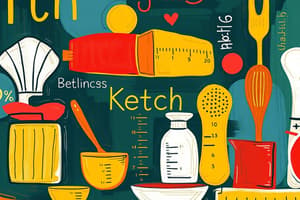Podcast
Questions and Answers
Which of the following is NOT a type of measuring cup?
Which of the following is NOT a type of measuring cup?
- Dry measuring cup
- Cup measuring cup (correct)
- Measuring spoon
- Liquid measuring cup
What is the purpose of a colander?
What is the purpose of a colander?
- To fry and brown food
- To mix ingredients
- To hold sauces and liquids
- To rinse and drain food (correct)
What is the main function of a microwave oven?
What is the main function of a microwave oven?
- To shave the skin off of vegetables
- To rinse and drain food
- To mix food ingredients
- To heat, reheat, defrost, and cook foods (correct)
Which of the following is NOT a unit of weight?
Which of the following is NOT a unit of weight?
What does it mean for a food to be nutrient-dense?
What does it mean for a food to be nutrient-dense?
Which type of fruit consumption is recommended?
Which type of fruit consumption is recommended?
What color vegetables should be consumed?
What color vegetables should be consumed?
How many ounces of seafood should be consumed per week?
How many ounces of seafood should be consumed per week?
What percentage of grains should be whole grain?
What percentage of grains should be whole grain?
What type of dairy products should be chosen?
What type of dairy products should be chosen?
Which of the following is NOT a guideline for personal cleanliness in the kitchen lab?
Which of the following is NOT a guideline for personal cleanliness in the kitchen lab?
What should be done with wet dishcloths, dishtowels, aprons, and sponges in the kitchen lab?
What should be done with wet dishcloths, dishtowels, aprons, and sponges in the kitchen lab?
What should be done with wet or dirty items in the kitchen lab?
What should be done with wet or dirty items in the kitchen lab?
What should be done with mop water in the kitchen lab?
What should be done with mop water in the kitchen lab?
What is the major source of staphylococcal bacteria in the kitchen lab?
What is the major source of staphylococcal bacteria in the kitchen lab?
What is the first and foremost consideration in the kitchen food lab?
What is the first and foremost consideration in the kitchen food lab?
What should be done with sinks after each lab class in the kitchen lab?
What should be done with sinks after each lab class in the kitchen lab?
What should be done with wet things in the kitchen lab?
What should be done with wet things in the kitchen lab?
What should be done with wet or dirty items in the kitchen lab?
What should be done with wet or dirty items in the kitchen lab?
What should be done with mop water in the kitchen lab?
What should be done with mop water in the kitchen lab?
Which of the following is the correct way to prevent the transfer of bacteria after handling raw meat, fish, poultry, or eggs?
Which of the following is the correct way to prevent the transfer of bacteria after handling raw meat, fish, poultry, or eggs?
What should you do to kill bacteria on counters and cutting boards?
What should you do to kill bacteria on counters and cutting boards?
What is the correct way to handle knives to prevent cuts?
What is the correct way to handle knives to prevent cuts?
What should you do if a knife, scissors, or ice pick falls?
What should you do if a knife, scissors, or ice pick falls?
What should you do if you smell gas in the kitchen?
What should you do if you smell gas in the kitchen?
What should you do if cloth catches fire?
What should you do if cloth catches fire?
What should you do to prevent falls in the kitchen?
What should you do to prevent falls in the kitchen?
What should you do to prevent electric shock in the kitchen?
What should you do to prevent electric shock in the kitchen?
What should you do to prevent choking in the kitchen?
What should you do to prevent choking in the kitchen?
What is the purpose of a sifter in the kitchen?
What is the purpose of a sifter in the kitchen?
Flashcards are hidden until you start studying




